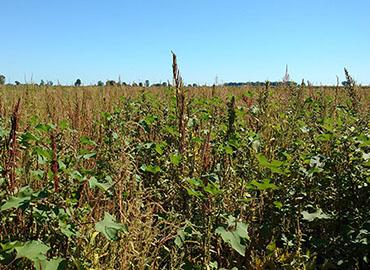U of T evolutionary biologists track the invasion of herbicide-resistant weeds from south of the border

A field of soy bean plants on Walpole Island in southwestern Ontario entirely overrun by common water hemp. Photo: Julia Kreiner
A team including evolutionary biologists from the University of Toronto have identified the ways in which herbicide-resistant strains of an invasive weed named common waterhemp have emerged in fields of soy and corn in southwestern Ontario.
They found that the resistance — which was first detected in Ontario in 2010 — has spread thanks to two mechanisms: first, pollen and seeds of resistant plants are physically dispersed by wind, water and other means; second, resistance has appeared through the spontaneous emergence of resistance mutations that then spread.
The researchers found evidence of both mechanisms by comparing the genomes of herbicide-resistant waterhemp plants from Midwestern U.S. farms with the genomes of plants from Southern Ontario.
“We used modern methods of genome analysis to look at the genetic similarity of different populations of these plants” explains Julia Kreiner, a PhD-candidate in the Department of Ecology & Evolutionary Biology (EEB) in U of T’s Faculty of Arts & Science and lead author on the study published today in Proceedings of the National Academy of Sciences .
“To our surprise, we found that the genomes of some resistant plants in Ontario were nearly identical to those in very distant U.S. plants. This was evidence that the Ontario plants were very closely related to the U.S. plants and suggests that the former came from seeds that were just picked up from one field and dropped in another.”
While Kreiner and her collaborators did not determine exactly how the seeds were physically transported, this propagation — known as gene flow — is typically accomplished in different ways. Seeds can be carried by water, or in the digestive tracts of animals, or from field to field by way of farm equipment. And especially with a wind-pollinated plant like common waterhemp, genes can also be spread via wind-borne pollen.
The same DNA analysis identified some resistant plants that did not genetically match any other plants suggesting they appeared through the independent emergence of a genetic mutation conveying resistance.
The researchers were surprised to discover both mechanisms at play.
“We have two regions, Walpole Island and Essex County in southwestern Ontario, where waterhemp populations evolved resistance,” says Stephen Wright, a professor in ecology & evolutionary biology at U of T and a co-author of the study.
“Because of their proximity, our expectation was that they would have shared the same origin of resistance. But our results suggest different origins — from the movement of seed from a source population in the U.S. as well as independent evolution of resistance in a local population.”
According to John Stinchcombe, also a professor in ecology & evolutionary biology at U of T and a co-author, “One of the most striking findings is that we see both ways that weeds could become resistant happening on really short time scales. Evolution is happening very quickly, and using multiple mechanisms.”
Full story:

